Design and implementation of a low-cost malaria diagnostic system based on convolutional neural network
引用次数: 0
Abstract
This work focuses on the design and implementation of an intelligent system that can diagnose malaria from blood smear images. This system takes data in the image format and provides an instant and automated diagnosis to output the result of the patient’s condition on a screen. The methodology for achieving the system is based on the CNN (convolutional neural network). The latter has the specificity to function as a feature extractor and image classifier. The software part thus obtained is implemented in an electronic device that serves as a kit mounted with our care. The establishment of such a system has innumerable assets, such as rapidity during diagnosis by a laboratory technician or not; its portability that will facilitate its use wherever needed. From an ergonomic and functional point of view, the system has a real impact in the diagnosis of a large-scale malaria endemic. The CNN was trained on a large dataset of blood smears and was able to accurately classify infected and uninfected samples with high sensitivity and specificity. Insofar as the system carried out after testing on several samples reaches an average sensitivity of 89.50% and an average precision of 89%, this improves decision-making on the diagnosis of malaria. The system thus created allows malaria to be diagnosed at low cost from blood smear images. The use of CNNs in this project has the advantage of automatically extracting features from blood smear images and classifying them efficiently. The major advantage of the proposed system is its portability and lower cost. The performance of the proposed algorithm was evaluated on a publicly available malaria data set.

基于卷积神经网络的低成本疟疾诊断系统的设计与实现
这项工作的重点是设计和实现一个智能系统,可以从血液涂片图像诊断疟疾。该系统以图像格式获取数据,并提供即时和自动的诊断,将患者的病情结果输出到屏幕上。实现该系统的方法是基于CNN(卷积神经网络)。后者具有作为特征提取器和图像分类器的特异性。由此获得的软件部分在一个电子设备中实现,该设备作为一个工具包安装在我们的护理中。建立这样一个系统具有无数的优势,例如实验室技术人员在诊断过程中是否快速;它的可移植性将使它在任何需要的地方都能使用。从人体工程学和功能的角度来看,该系统对大规模疟疾地方病的诊断具有实际影响。CNN在一个大型的血液涂片数据集上进行训练,能够以高灵敏度和特异性准确地对感染和未感染的样本进行分类。在对几个样本进行测试后,该系统的平均灵敏度达到89.50%,平均精度达到89%,这改善了疟疾诊断的决策。这样创建的系统可以通过血液涂片图像以低成本诊断疟疾。在本课题中使用cnn具有从血液涂片图像中自动提取特征并进行高效分类的优点。该系统的主要优点是可移植性和低成本。在一个公开可用的疟疾数据集上评估了所提出算法的性能。
本文章由计算机程序翻译,如有差异,请以英文原文为准。
求助全文
约1分钟内获得全文
求助全文

 求助内容:
求助内容: 应助结果提醒方式:
应助结果提醒方式:


